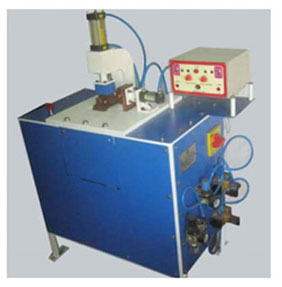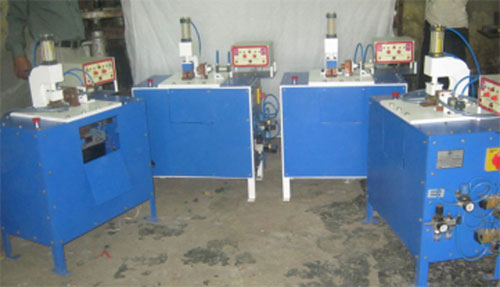Heating Machines Manufacturer & Exporter


Electromech Corporation introduces AUTOMATIC ONE END FILE HEATING MACHINE
We are a team of qualified and experienced Engineers and Technicians. We are pleased to inform you that we have successfully come out with a unique – FIRST TIME IN INDIA – special purpose Resistance Heating Machine which is very useful for Engineers’ File manufacturers. This machine is used in place of existing Gas Burners for heating the file ends before forging.
The special design used in this machine helps to heat the job faster with considerable lesss current. Since the Time and Current is less, the electrical energy consumption, which is proportional to the time and square of current, is considerably reduced and hence the operation cost of this machine is negligible compared to gas heating. Apart from the financial benefits, this machine is absolutely Eco friendly compared to gas heating.


We have successfully established this heating system with three of the following leading file manufacturers in India.

The range of Resistance Heating Machine offered by us is made up of high quality raw material and has unique features. It is noise-free and environment friendly. Acknowledged for its high strength and durability, the range is actively used in various industries.

Electric resistance heating is defined as “the heat produced by passing an electric current through a material that preferably has high resistance.” As the current passes through the material, ohmic losses (I2R losses) occur. These losses cause the conversion of electrical energy into heat.
There are two methods of electric resistance heating: Direct electric resistance heating and indirect electric resistance heating. In direct electric resistance heating, the current is passed directly through the material that has to be heated, for example, resistance welding. In the indirect electric resistance heating, the current is passed through a highly resistive material placed inside an oven, for example, domestic cooking, room heaters, and so on.
Heating Element Wires / strips, Electric Resistance Wire / strips, Electric Heaters, Coil / spring / spiral heating Elements, Corrugated Strip Type Heating Elements, Rod Over bend ( ROB ) Heating Elements, Tubular Heaters, Bundle Rod, Radiant tube Heating Elements, Nichrome Ni/Cr 80/20, FeCrAl heaters, Bare wire/strip heaters for use in ovens and furnaces, Silicon Carbide SiC elements, Molybednum ( MoSi2 ), Finned Air Heaters with Fins, Commercial and Immersion Water, Oil Immersion Heaters, Cartidge Heater are our main products. Products shown in our catalogue / website comprise only our standard range. We specialize in the manufacture of custom-built heaters as per the client’s requirement, and provide a complete solution form concept to design and final manufacture.
Today’s designers, specifiers and end users of electric furnaces and kilns are presented with a wide range of choices with respect to heating elements. As always, the details of any given application can influence the final selection and design of the appropriate electric heating element. However, by understanding the different classes and characteristics of the most often used heating elements, as well as the general guidelines for their selection, users can be certain that they choose the right elements for their application Electric resistance heating is 100% energy efficient in the sense that all the incoming electric energy is converted to heat. However, most electricity is produced from coal, gas, or oil generators that convert only about 30% of the fuel's energy into electricity. Because of electricity generation and transmission losses, electric heat is often more expensive than heat produced in homes or businesses that use combustion appliances, such as natural gas, propane, and oil furnaces.
If electricity is the only choice, heat pumps are preferable in most climates, as they easily cut electricity use by 50% when compared with electric resistance heating. The exception is in dry climates with either hot or mixed (hot and cold) temperatures (these climates are found in the non-coastal, non-mountainous part of California; the southern tip of Nevada; the southwest corner of Utah; southern and western Arizona; southern and eastern New Mexico; the southeast corner of Colorado; and western Texas). For these dry climates, there are so few heating days that the high cost of heating is not economically significant.
Electric resistance heating may also make sense for a home addition if it is not practical to extend the existing heating system to supply heat to the new addition.
